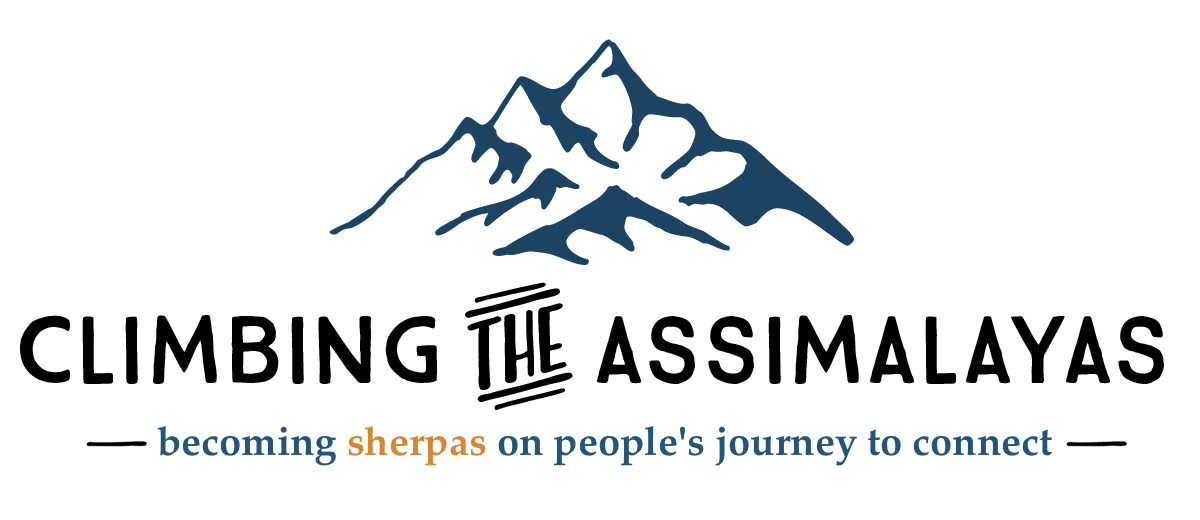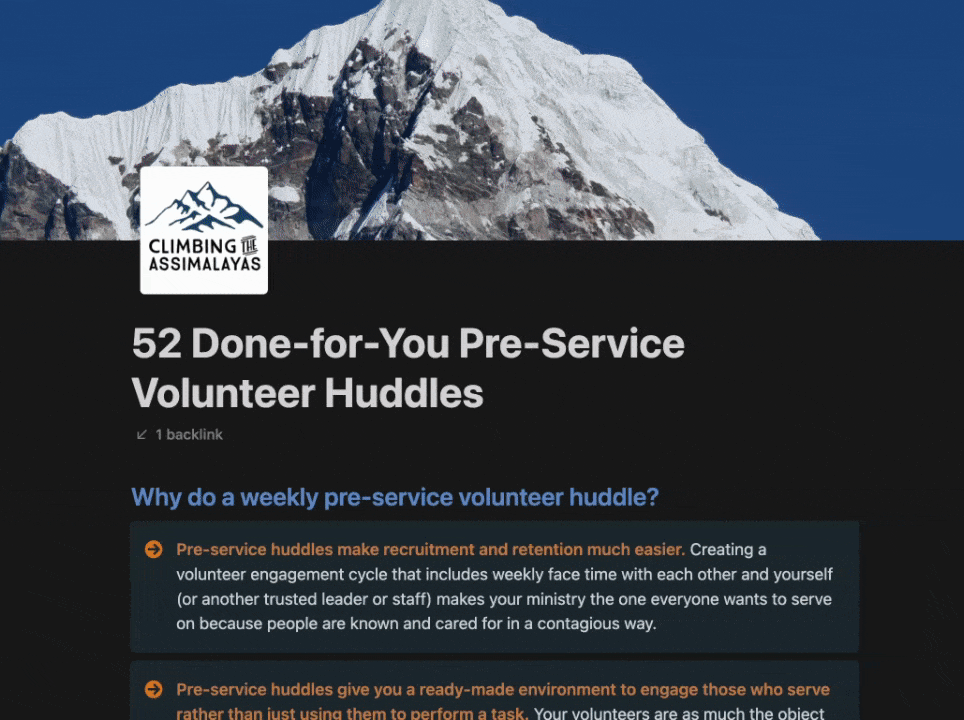The easiest way to retain (and disciple) volunteers
I live in a small home with a big view. I love being outside, and when people come over I want them to enjoy it too.
So I set out patio chairs and a table near the edge of the lawn where you can see the lake, the wildlife, the whole thing.
…it didn’t work.
Guests would drift out for a minute, but they rarely stayed. I kept coaxing: “Come sit out here! This is the best spot!”
They’d smile, wander back inside, and choose the most inconvenient chair in the house—the one they’d consistently forfeit the view for.
Then I got smart.
I bought a few Adirondack chairs and placed them right at the edge of the lawn, with a small side table I built for drinks. Suddenly, when people arrived, they bee-lined to the best seat on the property—the one they used to ignore.
I didn’t change the scenery. I changed the environment.
That’s the power of environments.
They’re an essential ingredient of your church, too. And there’s one environment that’s been quietly transforming our volunteer placement, retention, and development:
A 10–15 minute pre-service huddle.
It’s created a family feel on our teams and, over time, it’s become the easiest way we disciple volunteers.
What Huddles Are (and Aren’t)
Huddles are an environment where people naturally move to higher ground—spiritually and in their personal impact.
They are not:
Another Sunday devotion (they’ll hear a message in worship).
Ten extra minutes of housekeeping and announcements.
They are a weekly rhythm that builds skills, wisdom, and community. If you’re not doing those three, the time will feel disjointed and unnecessary.
The Weekly Huddle Framework
Here’s the weekly framework we use every weekend:
Information
Yes, you still need information - but limit yourself to a minute. Seriously. Share the essential schedule, changes, or reminders and move on.
Inspiration
Get eyes up above whatever people walked in carrying. Connect the role to the mission and the people you’ll serve today (and beyond). This is where you engage hearts.
Prayer
Prayer connects us to God and to each other. It centers the morning and reminds us we’re not just doing tasks; we’re joining God in what He’s already doing.
That’s what goes into every huddle.
The Monthly Rhythm That Keeps It Fresh
To avoid repeating yourself or grabbing a random verse you just read on YouVersion (we’ve all done it), we rotate a simple monthly cadence:
Week 1 — VISION
Tell a story, watch a killer video, connect the dots: why this matters, and why living for others is transferrable to rest of their everyday lives.
Week 2 — TRAINING
One soft skill or best practice that makes the team better this weekend.
Week 3 — APPRECIATION
Call out wins. Share a quick testimony. Celebrate faithfulness by name. Help them notice and celebrate each other.
Week 4 — PRAYER
Pray for guests, for volunteers, for each other, and for what God wants to do among us.
[Week 5 — Dealer’s Choice]
I usually go with Training again.
Ten minutes. Every weekend. Purpose + predictability = momentum.
Why Huddles Work (The Results We See)
This isn’t just nice theory. Huddles produce compounding outcomes:
1) Engagement over extraction
Pre-service huddles give you a ready-made environment to engage your volunteers—not just use them to perform a task. Your volunteers are as much the object of your ministry as those they serve, just in a different way. Huddles ensure the kind of engagement that actually develops people.
2) Recruitment and retention get easier
A weekly face-to-face touchpoint creates a volunteer engagement cycle where people are known, cared for, and invited to grow. That contagious experience draws new people in and gives current volunteers reasons to stay.
3) Leadership essentials get automated
Vision casting, training, appreciation, spiritual development, prayer—these are the things leaders most worry about forgetting. Because they’re built into a short, reliable rhythm, you don’t have to hunt the calendar for the “perfect time” to do them. You just do them—every week.
Why Huddles Work (The Results We See)
This isn’t just nice theory. Huddles produce compounding outcomes:
➊ Engagement over extraction
Pre-service huddles give you a ready-made environment to engage your volunteers—not just use them to perform a task.
Your volunteers are as much the object of your ministry as those they serve, just in a different way. Huddles ensure the kind of engagement that actually develops people.
➋ Recruitment and retention get easier
A weekly face-to-face touchpoint creates a volunteer engagement cycle where people are known, cared for, and invited to grow. That contagious experience draws new people in and gives current volunteers reasons to stay.
People want to be on a TEAM — not just do a JOB. Jesus modeled this for us better than anyone.
➌ Leadership essentials get automated
Vision casting, training, appreciation, spiritual development, prayer—these are the things leaders most worry about forgetting.
Because they’re built into a short, reliable rhythm, you don’t have to hunt the calendar for the “perfect time” to do them. You just do them—every week.
How to (realistically) start or reinvent what you’re already doing.
You might be thinking: “This sounds great, but I can barely get everything done as it is.”
I get it. You’re already stretched thin. Planning creative, engaging, and meaningful huddles every week feels impossible—and that’s before you even figure out how to get everyone there on time.
But if you make a few small adjustments on the front end, it’s completely doable. Here’s how.
If you’re not already doing pre-service huddles:
➡️ Rearrange call times.
Adjust the schedule for each role by about 10 minutes. If you can, shave 5 minutes off the role itself so you’re not just adding time to the morning.
➡️ Give a two- to three-week runway.
Announce the change early and often. Text it. Email it. Say it in person. Set clear expectations.
➡️ Share the “why.”
Tell your teams how these ten minutes will grow their skill, influence, and team culture. Get them excited for what’s coming.
➡️ Start with momentum.
Bring energy to your launch month—good snacks, prayer experiences, maybe a quick drop-in from your lead pastor. Make those first few weeks memorable.
If you’re already doing them, but need to reinvent:
➡️ Plan your first month in advance.
Build a four-week plan you can actually sustain. Consistency matters more than creativity.
➡️ Recast vision before your relaunch.
Send a message telling your team what’s going to be different. Tease the snacks (food always helps), preview the topic, and invite them personally to be there.
➡️ Name the gap and thank your team.
It’s okay to admit that huddles might have felt flat. Your honesty will reinforce that you’re working to serve them better.
➡️ Ask for feedback.
Keep the conversation open. The best way to build ownership is to co-create the experience with your volunteers.
How to Fully Plan the next year of Huddles… in About 15 Minutes
I’ve been leading huddles for years.
Some were absolute home runs. Some… not so much.
So when leaders ask, “What do you actually do each week?” — I get it.
There are land mines everywhere:
How to make training bite-sized, helpful, and memorable.
How to do vision without sounding preachy.
How to make things fun without being cringey.
How to pray together without the moment drifting off course.
That’s why we pulled together 52 complete, field-tested pre-service huddle plans you can use, customize, and hand off to your leaders immediately.
These are the best of the best from the last seven years of weekly huddles.
They’re fun, interactive, and power-packed—but still simple enough for any team to run.
Here’s how they’re balanced:
🧭 12 Vision Huddles
🧰 16 Training Huddles
🎉 12 Appreciation Huddles
🙏 12 Prayer Huddles
That’s a full year’s worth of discipleship environments—already mapped out and ready to go.
And because they’re virtually plug-and-play, you can delegate them to emerging leaders as a built-in training tool.
You don’t have to create something new every week.
You just have to create space—and show up faithfully.
Try the Sherpa Tribe for a Month
If you want instant access to all 52 huddle plans, just jump in our coaching membership platform for a month (which we call The Sherpa Tribe).
Inside the Sherpa Tribe you’ll get:
✅ 52 ready-to-use huddle plans (vision, training, appreciation, and prayer)
🎥 A 30-day Action Plan video series to help you implement them with confidence
🖥️ Weekly Group Coaching Calls to help you contextualize, troubleshoot, and personalize your plans
8️⃣ More Assimilation Action Plans to help you upgrade your entire system
📘 100+ plug-and-play resources—job descriptions, email templates, volunteer tools
🤝 Access to a community of leaders who are doing the same thing
We used to sell these huddle plans for more than a month of Tribe access costs now.
Today, you can try it risk-free for one month and walk away with a stronger volunteer culture, guaranteed.
Use these questions to debrief and plan with your team or volunteers.
➊ What environments in our church are producing the most growth in our volunteers right now?
➋ Have you ever experienced a truly great pre-service huddle? How did that shape the way you lead—or why you haven’t started yet?
➌ What’s a realistic but ambitious goal for launching or reinventing huddles on your team? (Set due dates and assign owners!)
➍ How much time and energy could the 52 Done-for-You Huddles save you this year?



